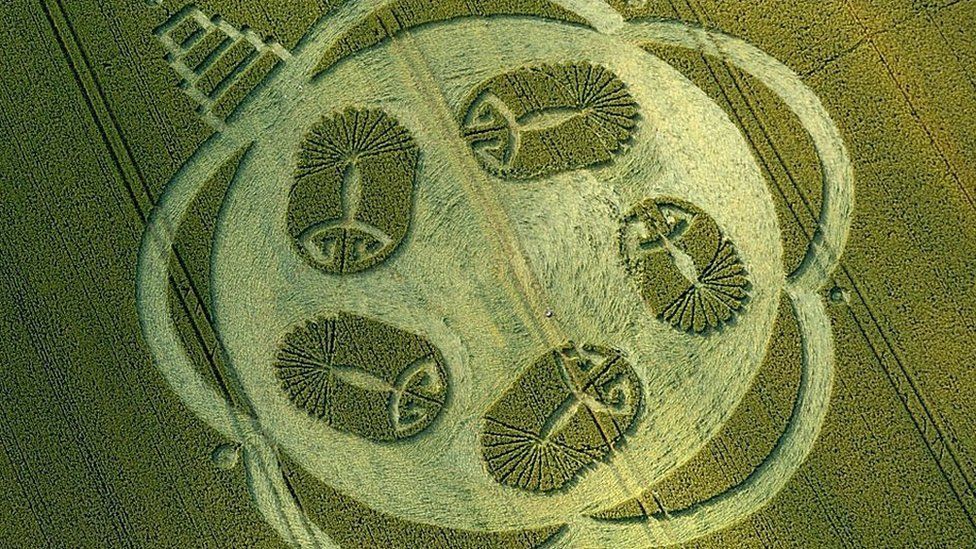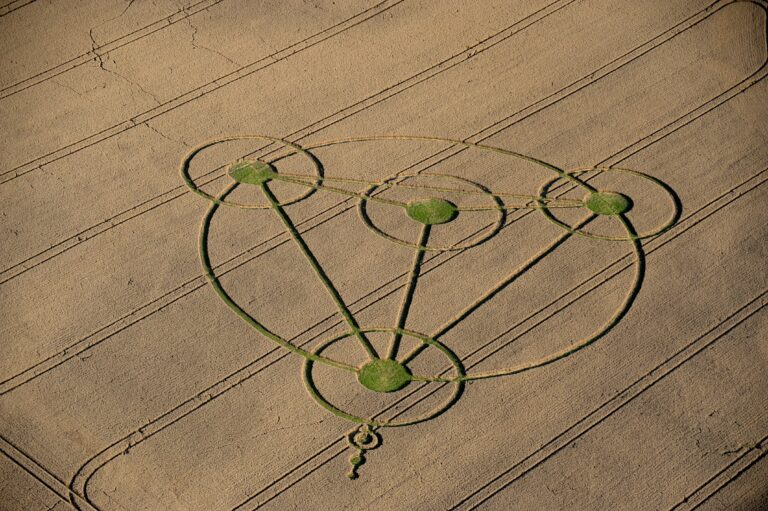In the heart of lush fields and tranquil landscapes, an enigmatic phenomenon has left its indelible mark, challenging our understanding of the natural world—the perplexing world of crop circles. These intricate and often mesmerizing patterns, seemingly etched overnight into fields of golden wheat or vibrant canola, have captured the imagination of people worldwide. Yet, beneath the surface of their aesthetic allure lies a profound mystery: are crop circles the result of elaborate hoaxes and human craftsmanship, or do they hold the key to unexplained phenomena that transcend our current understanding? In this journey of exploration, we delve into the captivating world of crop circles, peeling back the layers of intrigue to examine the evidence, theories, controversies, and the profound questions they inspire.
While the term “crop circle” entered the popular lexicon in the latter half of the 20th century, the phenomenon itself has roots that reach far back in time. Early accounts, though simpler and more rudimentary in design, hint at a history intertwined with superstition, folklore, and a sense of the mysterious. As we embark on this exploration, we’ll trace the origins of crop circles, from early mentions in historical records to their emergence as complex geometric wonders in the modern era.
The story of crop circles takes us on a journey through the English countryside, where their modern form first captured the world’s attention in the 1970s. These early formations marked a turning point, transforming what were once basic circles into elaborate, mathematically precise designs that defied easy explanation. From these initial appearances to the present day, crop circles have continued to evolve, leaving an indelible mark on the landscape and the human psyche.
Intriguingly, the story of crop circles is not one-dimensional. It is a tale of duality, with two distinct narratives intertwined—one championed by skeptics, firmly rooted in human creativity and ingenuity, and the other driven by enthusiasts and believers who see in crop circles the handiwork of forces beyond our comprehension. It is a story of an unending debate, where skepticism and wonder coexist, each seeking to uncover the truth behind these enigmatic formations.
We’ll navigate this multifaceted landscape, exploring the artistry of hoaxes and the complexity of human-made crop circles. We’ll delve into the unexplained crop circles that continue to baffle researchers and enthusiasts alike, examining their unique characteristics and the scientific investigations that have sought to unveil their secrets. Along the way, we’ll encounter a diverse tapestry of theories, from natural phenomena to extraterrestrial involvement, each adding a layer of complexity to the mystery.
These represent a confluence of science, art, psychology, and spirituality, making their study a multidisciplinary puzzle. As we explore the evidence and theories, we’ll gain insight into the complexity of this phenomenon, where the line between the known and the unknown blurs, inviting us to question, wonder, and explore.
In the end, whether one views crop circles as products of human artistry, intricate hoaxes, or unexplained mysteries, they remain a testament to the enduring power of curiosity and inquiry. The phenomenon of crop circles serves as a reminder that our world is filled with wonders waiting to be discovered, mysteries yearning to be unraveled, and questions that challenge the limits of our understanding. As we embark on this journey into the enigmatic realm, we are beckoned to explore the unknown, question the unexplained, and marvel at the intricate patterns that grace our world’s fields—an invitation to step into the circle of curiosity.
A Puzzling Phenomenon Emerges

The history of crop circles is more extensive than many may realize. While the term “crop circle” was coined in the 1980s, reports of such phenomena date back centuries. Early accounts often describe simple circular patterns, and some are steeped in folklore and superstition.
One notable early account is the “Mowing Devil” pamphlet from 1678, which depicts a woodcut of a devilish figure creating a circular pattern in a field of oats. The pamphlet suggests that the devil himself was responsible for the crop formation, a reflection of the prevailing beliefs and fears of the time.
It wasn’t until the late 20th century that crop circles gained significant attention and took on more intricate forms. The phenomenon’s emergence in England’s Wiltshire County in the 1970s marked the beginning of a new era. These formations were no longer simple circles but complex designs with geometric precision.
The Artistry of Hoaxes
One of the primary arguments against the unexplained nature of crop circles is the undeniable presence of human-made formations. Indeed, many are the result of skilled artists and pranksters, equipped with planks, ropes, and boards to flatten the crops. Some of these individuals have admitted to creating the designs as art projects or hoaxes.
Human-made crop circles often exhibit characteristics that set them apart from their unexplained counterparts. They tend to have flattened, broken, or damaged crop stalks, and they often lack the intricate details and precision seen in the more mysterious formations. Skeptics argue that the existence of human-made casts doubt on the authenticity of all such formations.
The presence of both unexplained and human-made crop circles has given rise to a curious subculture known as the “crop circle war.” In this ongoing battle, crop circle enthusiasts and believers contend with skeptics and debunkers. While some people are convinced that all crop circles are genuine mysteries, others are equally adamant that they are all elaborate hoaxes.
The rivalry has led to an intriguing blend of science, artistry, and skepticism. Researchers employ various methods, from measuring magnetic anomalies to analyzing soil and plant samples, to distinguish between genuine and human-made. This ongoing debate underscores the complex nature of the phenomenon.
Unexplained Crop Circles
Amid the sea of human-made formations, certain crop circles continue to baffle researchers and enthusiasts alike. These genuine crop circles exhibit characteristics that set them apart from the hoaxes. Key features include:
- Elaborate Detail: Genuine crop circles often feature intricate and precise designs that are challenging to replicate with simple tools.
- Bent, Not Broken Stalks: Unlike human-made circles, the crop stalks in genuine formations are bent at the nodes, rather than broken or damaged.
- Electromagnetic Anomalies: Some crop circles exhibit unusual electromagnetic readings, suggesting possible energy-related phenomena.
Scientific Investigations
To explore the authenticity of crop circles, scientists and researchers have undertaken various investigations. These studies often involve analyzing soil and plant samples, conducting magnetic field measurements, and examining the physical properties of the crop formations.
One intriguing aspect of genuine crop circles is the presence of elongated and bent nodes in the crop plants. Some researchers have proposed that microwave or ultrasound energy could be responsible for these effects. However, these hypotheses remain speculative and require further investigation.
Theories and Speculations
While some crop circles are undoubtedly the work of humans, others appear to defy easy explanations. Numerous theories have been proposed to account for these mysterious formations, and some of them involve natural phenomena. These include:
- Plasma Vortices: Some researchers suggest that atmospheric phenomena, such as plasma vortices or ball lightning, could create the swirling patterns seen in crop circles.
- Earth Energies: New Age and alternative theories posit that crop circles are the result of Earth energies, ley lines, or other mystical forces that interact with the environment.
Extraterrestrial Hypotheses
One of the most intriguing and controversial theories surrounding crop circles involves extraterrestrial involvement. Some proponents of this theory argue that advanced civilizations from other planets or dimensions are responsible for creating these formations as messages or artistic expressions.
The “alien” hypothesis has led to speculation about the potential symbolism and meaning behind crop circles. Some believe that they contain encoded messages or sacred geometry that can offer insights into advanced extraterrestrial civilizations.
The Complexity of Crop Circle Research
Crop circles represent a multidisciplinary puzzle that encompasses elements of science, art, psychology, and spirituality. Researchers approach the phenomenon from various angles, each seeking to uncover the truth behind these enigmatic formations.
The study of crop circles requires a combination of fieldwork, laboratory analysis, and collaboration among experts in different fields. Researchers must grapple with the challenges posed by the presence of both genuine and man-made formations, as well as the diversity of theories and beliefs surrounding the phenomenon.
The Cultural Impact of Crop Circles
Crop circles have become a fixture of popular culture, often portrayed in movies, television shows, books, and documentaries. These portrayals range from science fiction tales of alien encounters to more grounded explorations of the phenomenon’s cultural and psychological significance.
The media’s portrayal has both fueled public fascination and perpetuated the mystery surrounding them. While some media coverage focuses on the scientific investigations and the debate between skeptics and believers, others sensationalize the phenomenon, emphasizing its purported extraterrestrial connections.
The allure has not only captured the attention of the media but also enticed curious travelers and enthusiasts to visit crop circle hotspots. In regions where crop circles are prevalent, such as southern England, tourism related to the phenomenon has become a thriving industry.
Crop circle tours and guided visits offer visitors the opportunity to explore these enigmatic formations up close. For some, these excursions are purely recreational, while for others, they represent a quest for answers and a deeper connection to the mystery.
The Unending Debate
Crop circles, those intricate patterns that grace the world’s fields, embody an enduring enigma—one that has sparked a spirited and unending debate. Are they the elaborate creations of human hands, the result of sophisticated hoaxes and artistic endeavors? Or do they represent something beyond our current understanding of natural phenomena? In this chapter, we dive deep into the heart of this unending debate, where skeptics and believers collide, and where the boundary between what we know and what we can only wonder about blurs.
The Skeptics’ Stance
Skeptics stand firm in their conviction that crop circles are entirely man-made. They argue that the intricate designs are a testament to human creativity and craftsmanship, rather than mysterious forces at play. The skeptical perspective posits several key arguments:
- Evidence of Human Involvement: Skeptics point to the overwhelming evidence of human involvement in creating crop circles. Numerous individuals and groups have come forward to claim responsibility for crafting these patterns, often providing detailed explanations of their methods and tools.
- Hoaxing as Art: Many skeptics view crop circle creation as an art form in itself. They argue that the patterns are crafted to provoke thought, inspire awe, or convey social and cultural messages. These individuals, often called “circle makers,” create crop circles as a form of artistic expression, pushing the boundaries of human ingenuity.
- Lack of Scientific Proof: Skeptics contend that the scientific evidence supporting the existence of unexplained crop circles is insufficient. They argue that, while some may exhibit unique characteristics, these anomalies can be attributed to natural processes or even deliberate manipulation by the circle makers.
The Believers’ Perspective
On the other side of the debate are the believers—those who insist that some crop circles defy conventional explanation and may represent interactions with unknown or supernatural forces. Their arguments encompass a range of theories and beliefs:
- Distinct Characteristics: Believers point to the unique features exhibited by certain crop circles that set them apart from human-made designs. These features include precise geometric shapes, intricate mathematical ratios, and the presence of bent, not broken, crop stalks.
- Witness Testimonies: Some crop circle enthusiasts cite witness testimonies of unusual phenomena associated with the appearance of these formations. These accounts include reports of strange lights, electromagnetic disturbances, and personal experiences that defy logical explanations.
- Alien and Paranormal Theories: Among believers, theories about extraterrestrial involvement or paranormal forces often find traction. Some suggest that advanced civilizations from other planets or dimensions are responsible for creating these patterns as messages or artistic expressions.
The Complexity of Crop Circle Research
The debate surrounding crop circles is a complex and multifaceted one. Researchers, enthusiasts, and skeptics alike are engaged in a continuous exploration of this phenomenon. The intricacy of the debate arises from several factors:
- Diverse Patterns: Crop circles are not a uniform phenomenon; they encompass a vast array of designs, ranging from simple circles to intricate and mathematically precise formations. This diversity challenges researchers to develop a comprehensive understanding of the phenomenon.
- Human-Made vs. Unexplained: The presence of both human-made and unexplained crop circles further complicates the debate. Researchers must contend with the coexistence of formations crafted by human hands and those that defy easy explanation.
- Interdisciplinary Nature: The study of crop circles requires an interdisciplinary approach, involving fields such as agronomy, physics, psychology, and cultural studies. Researchers must draw on various methodologies and expertise to explore the phenomenon comprehensively.
- Ongoing Investigations: Crop circle research is an ever-evolving field, with ongoing investigations, fieldwork, and collaborations among experts. Researchers continue to explore new theories, analyze crop circle characteristics, and seek to unravel the mystery.
Balancing Skepticism and Wonder
The unending debate over crop circles encapsulates the delicate balance between skepticism and wonder. For skeptics, the burden of proof lies with those who claim that some are unexplained phenomena. They demand rigorous scientific evidence and verifiable data to support such claims, challenging enthusiasts and researchers to provide conclusive proof.
Believers, on the other hand, maintain that some circles possess characteristics that cannot be easily explained through conventional means. Their perspective invites curiosity and an open-minded approach to exploring the mysteries of these formations. They emphasize the need to continue investigating and seeking answers beyond what is currently understood.
The Invitation to Explore
Crop circles, whether the product of human artistry or unexplained forces, invite us to explore the boundaries of our understanding and imagination. They challenge us to question the limits of our knowledge and to consider the possibility of phenomena that may exist beyond our current comprehension.
As we navigate the unending debate surrounding us, we find ourselves immersed in a world where science, art, belief, and skepticism intersect. We are reminded that the mysteries of our world are not easily unraveled and that the pursuit of truth often involves navigating the complexities of human curiosity and creativity.
Ultimately, whether one views crop circles as elaborate hoaxes, natural occurrences, or unexplained phenomena, they remain a testament to the enduring power of wonder and inquiry. The phenomenon of crop circles serves as a reminder that, in the vast tapestry of our world’s mysteries, there are patterns waiting to be discovered, enigmas yearning to be unraveled, and questions that defy easy answers. In the end, the invitation to explore the unknown, to question the unexplained, and to wonder at the wonders of our world remains open, extending to all who dare to step into the circle of curiosity.

